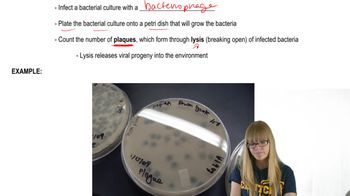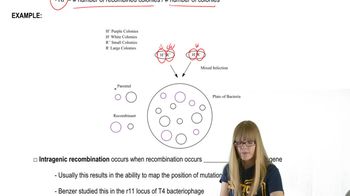Table of contents
- 1. Introduction to Genetics51m
- 2. Mendel's Laws of Inheritance3h 37m
- 3. Extensions to Mendelian Inheritance2h 41m
- 4. Genetic Mapping and Linkage2h 28m
- 5. Genetics of Bacteria and Viruses1h 21m
- 6. Chromosomal Variation1h 48m
- 7. DNA and Chromosome Structure56m
- 8. DNA Replication1h 10m
- 9. Mitosis and Meiosis1h 34m
- 10. Transcription1h 0m
- 11. Translation58m
- 12. Gene Regulation in Prokaryotes1h 19m
- 13. Gene Regulation in Eukaryotes44m
- 14. Genetic Control of Development44m
- 15. Genomes and Genomics1h 50m
- 16. Transposable Elements47m
- 17. Mutation, Repair, and Recombination1h 6m
- 18. Molecular Genetic Tools19m
- 19. Cancer Genetics29m
- 20. Quantitative Genetics1h 26m
- 21. Population Genetics50m
- 22. Evolutionary Genetics29m
5. Genetics of Bacteria and Viruses
Bacteriophage Genetics
Problem 22h
Textbook Question
Textbook QuestionIn studies of recombination between mutants 1 and 2 from Problem 21, the results shown in the following table were obtained. Strain Dilution Plaques Phenotypes E. coli B 10⁻⁷ 4 r E. coli K12 10⁻² 8 + When mutant 6 was tested for recombination with mutant 1, the data were the same as those shown above for strain B, but not for K12. The researcher lost the K12 data, but remembered that recombination was ten times more frequent than when mutants 1 and 2 were tested. What were the lost values (dilution and plaque numbers)?
 Verified Solution
Verified SolutionThis video solution was recommended by our tutors as helpful for the problem above
Video duration:
1mPlay a video:
Was this helpful?
Key Concepts
Here are the essential concepts you must grasp in order to answer the question correctly.
Recombination Frequency
Recombination frequency is a measure of how often recombination occurs between two genetic loci during meiosis. It is typically expressed as a percentage or a ratio, indicating the likelihood of producing recombinant offspring. In this context, understanding recombination frequency helps in predicting the expected outcomes of genetic crosses and interpreting experimental data.
Recommended video:
Guided course

Recombination after Single Strand Breaks
Mutant Phenotypes
Mutant phenotypes refer to observable traits that arise from genetic mutations. In the context of the question, the phenotypes of the E. coli strains (r and +) indicate different genetic alterations. Recognizing these phenotypes is crucial for analyzing the results of recombination experiments and understanding how mutations affect bacterial characteristics.
Recommended video:
Guided course

Mutations and Phenotypes
Dilution and Plaque Assays
Dilution and plaque assays are techniques used to quantify viral or bacterial populations. In this scenario, the dilution factor indicates the concentration of the bacterial culture, while the number of plaques represents the number of successful infections or colonies formed. These assays are essential for determining the effects of recombination and the viability of different strains in experimental setups.
Recommended video:
Guided course

Plaques and Experiments

 3:44m
3:44mWatch next
Master Plaques and Experiments with a bite sized video explanation from Kylia Goodner
Start learningRelated Videos
Related Practice


